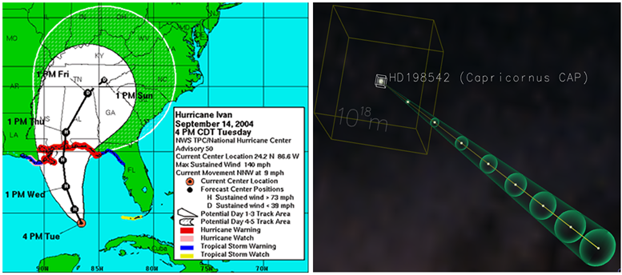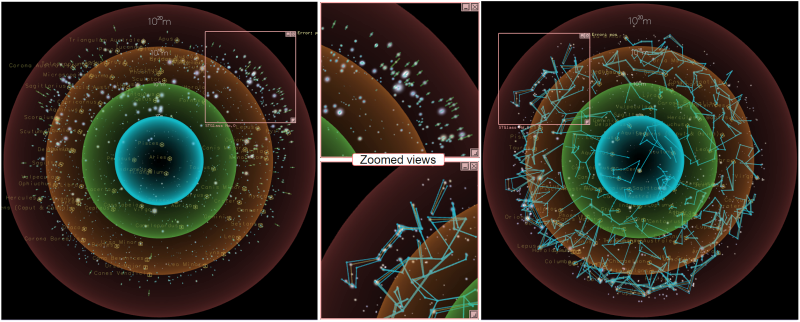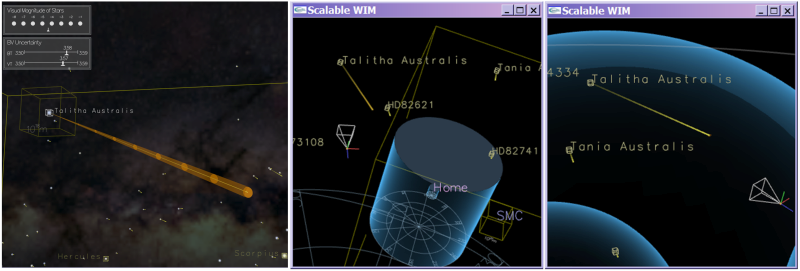
|
Visualizing Large-Scale Uncertainty in Astrophysical Data
Hongwei Li,
Chi-Wing Fu,
Yinggang Li,
and Andrew J. Hanson |
Abstract
Visualization of uncertainty or error in astrophysical data is seldom available in simulations of astronomical phenomena, and yet almost all rendered attributes possess some degree of uncertainty due to observational error. Uncertainties associated with spatial location typically vary significantly with scale and thus introduce further complexity in the interpretation of a given visualization. This paper introduces effective techniques for visualizing uncertainty in large-scale virtual astrophysical environments. Building upon our previous transparently scalable visualization architecture, we develop tools that enhance the perception and comprehension of uncertainty across wide scale ranges. Our methods include a unified color-coding scheme for representing log-scale distances and percentage errors, an ellipsoid model to represent positional uncertainty, an ellipsoid envelope model to expose trajectory uncertainty, and a magic-glass design supporting the selection of ranges of log-scale distance and uncertainty parameters, as well as an overview mode and a scalable WIM tool for exposing the magnitudes of spatial context and uncertainty.Type of Astrophysical Uncertainy
- Positional Uncertainty

Representing star positional uncertainty using error bars; from left to right, colors are assigned to annotate: 1) the percentage error of the distance uncertainty (for the most probable distance) to Earth, 2) the most probable distance, and 3) the absolute value of the distance uncertainty.
- Trajectory Uncertainty

Left: An example model showing trajectory uncertainty of a Hurricane. Right: presenting the trajectory uncertainty of a star in 50,000 years; note: the color reveals the percentage error.
- Magnitude and Color Uncertainty

Two on-screen plots of the user interface depicting the visual magnitude uncertainty (left) and B-V color uncertainty (right). See video presentation for a live demonstration.
User Interface Tools
- A Unified Color-coding Scheme

Unified color-coding scheme: using colors to encode and explore large-scale spatial uncertainty and percentage errors.
- The Magic Glasses

Moving the magic glass from left to right, exposing the properties of stars that are relatively close to us (within 10^18.6m), while providing appropriate visual cues to characterize positional certainty. Color is also used to annotate the absolute size of the uncertainty.
- The Log-Sky Visualization Mode

The log-sky visualization mode; Left: positional uncertainty (error bars) of stars; Right: positional uncertainty of constellation lines plotted in 3D; Middle: two zoomed views.
- The Scalable WIM

Using the Scalable WIM to explore and examine data uncertainty from a third-person viewpoint; Left: main window showing a trajectory uncertainty; Middle and Right: the Scalable WIM, as a popup window, exposes the spatial context around the uncertainty model.
Download
Click the following link to download:- Manuscript: download (~10.9 MB)
- Animation demo: download (~64.6 MB)
Encoded in AVI format using DIVX codec: WIN or MAC
BibTex
@article{li-2007-uncertainty,author = {Hongwei Li and Chi-Wing Fu and Yinggang Li and Andrew J. Hanson},
title = {Visualizing Large-Scale Uncertainty in Astrophysical Data},
journal = {IEEE Transactions on Visualization and Computer Graphics (IEEE Visualization 2007)},
month = {Nov.-Dec.},
year = {2007},
volume = {13},
number = {6},
pages = {1640--1647},
}